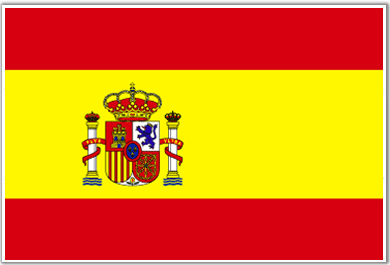Do you know how many times the Spanish flag has changed over the years? The Spanish flag is as intriguing as is the history of the region. Take a trip back in time to discover the metamorphosis of the Spanish flag.
The history of the Spanish flag can be traced back to the times when the concept of national flags was quite different from what it is today. It took more than a couple of centuries for the Spanish flag to come in to the shape, size and color that it is today. The Spanish flag was initially a symbol placed on a simple white or yellow background unlike the tricolor bands that we see today. The symbol that was embroidered in the centre of this simple piece of cloth was the Cross of Burgundy. At the time this symbol was adopted by the Spanish it seemed quite alien to the people. In later years it became embedded into the minds of the people as the symbol for the Spanish. The Cruz de San Andres as the symbol was known is considered to be a fundamental step in the evolution of the Spanish Flag.
The 16th Century Flag
The next century saw the House of Habsburg giving each military company its own flag. This was usually painted or embroidered on the arms of the commanders. The king had a variant of the flag made out of yellow silk for his personal representation. The flag during this time was yellow with the Cross of Burgundy in red. The 17th century saw the rising of Philip V to the throne. It was under his rule that the first real effort to make a unified flag of the country was made. A shield was added to the Cross of Burgundy and it was put on a white fabric. The rest of Europe was following a similar style with a symbol pasted on a white background for their flags as well. The royal flag during this time was of crimson color where as the military and naval flag was white with the Cross of Burgundy in the center.
The 17th century flag & Modern Spanish Flag
The foundations of the present ensign were laid down in the 17th century when the royal arms on the flag were modified. The necklace of the Holy Spirit was pushed into the background whereas the Golden Fleece was maintained. Charles III also added six blue lilies on gold and three lilies of gold along with five red discs. The king of that time made an interesting observation that gave birth to the coloring of the Spanish flag. He noticed that all other European nations had flags that were quite similar to each other. He wanted something that would make the Spanish flag stand out in battles and otherwise amongst the other European nations. Hence he ordered for variants of the flag to be developed and finally selected the tricolor flag with two red bands and one yellow band double the size of the red.
This new flag is the true ancestor of the modern Spanish flag. The only difference was that back then the civil and merchant marine ensign had five stripes instead of three. The successive governments that followed swayed back and forth amongst the colors and the design of the coat of arms on the Spanish flag. The current flag of Spain finally came to its last and final revision late 1970’s under the rule of Juan Carlos I.





